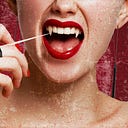15 Minutes of Fang:
Warhol as Vampire
“There was… enough Andy in Dracula — the pale, lifeless Carpathian vampire, embarrassed by his roots, lost in the modern world…”
— Victor Brockris, The Life and Death of Andy Warhol
For you barbarians, here’s a primer on Andy Warhol:
Canned Soup
Marilyn Monroe
The Velvet Underground
Interview Magazine
Assassinated with mixed results by Valerie Solanas
And for you connoisseurs, here’s a primer on his relationship to vampires:
Yeah he liked them.
It might seem odd that the king of pop art would be enthralled by a dated cultural reference rather than something that seemed fresh. Like, is Banksy really into the Cosby Show? That’s my equivalence.
Why was Warhol interested in vampires? And what was the depth of his interest? Just a casual fan? Or did he see something of himself in the vampire?
Forget Warhol’s deathly pale skin; his Factory nickname of “Drella” — a mashup of “Dracula” and “Cinderella” was apt, as he had a way of sucking the life out of those around him.
More to the point, he made not one but two feature films with Dracula as a character.
First was the 1964 black and white feature Batman/Dracula. The title pretty much says it: Batman and Dracula on the rooftops of New York City. And yet the title fails to preview just how bizarre and surreal the film is… or at least that which we can see. The film was yanked from Warhol exhibits following legal action by DC Comics and is considered lost, save for a few clips salvaged by documentarian Mary Jordan. It’s impossible to determine a plot from the rescued clips… unless maybe you are a more patient viewer than me.
Uncredited screenwriter Tyler Duncan said the film was “about Batman having to face an overwhelming evil villain that is associated with his own fear and himself,” referencing both Bruce Wayne’s childhood scare with bats, and the alter ego he adopted that tracks with Dracula’s own sometimes-form. I’m talking about Batman and bats here.
Writings about the film have largely focused on Batman and the influence the film may have had on the 1966 Adam West series. But many overlook that Warhol cast the same actor in both lead roles; suggesting that, at least in Warhol’s mind, there was an equivalence in the cultural importance of both Batman and Dracula.
Warhol did not return to Batman for another movie, but he did revive Dracula in 1974’s Blood For Dracula, sometimes called Andy Warhol’s Dracula or Young Dracula. Quite gory, it was supposed to be a humorous comment on sexual permissiveness.
It was the first film to posit that Dracula could only drink the blood of virgins. And therein lies the 100-minute-long joke: Drac can’t find a single virgin in these promiscuous times. Good one, Andy.
If the film was a critique of sexual mores, it’s a little ironic that cuts had to be made for the UK to release it as anything other than a porno.
But where did all this start?
Was Warhol simply picking up on pop culture and repackaging it as commentary as it came to him? Was he working in a void?
Maybe not. While Warhol’s vampire films get plenty of attention, nearly forgotten is one of his early silkscreens that foretold his continuing interest in revenants. 1963’s The Kiss (not to be confused with his short film Kiss) has all the trappings of a Warhol work: repetition, pop culture familiarity, attention to the medium as being a comment on the subject. And no one ever talks about it!
The piece is so overlooked that the internet — the same internet that has a Vampire Bill Cosby twitter and pics of Andy Warhol dressed as Robin — returns precious little info on it aside from transactions. The piece goes for the $4 million range if you’re in the market.
If Warhol’s use of vampires as a vessel for his art isn’t satisfying enough, consider the way he carried himself after he was shot by actress and author Valerie Solanas.
He was pronounced dead after the shooting, but somehow revived.
Gosh, that’s not entirely different from… being undead.
In her excellent essay “I, Monster: Gothic Metaphor in the Making and Unmaking of Andy Warhol,” Gilda Williams explores this further:
Having literally returned from the grave, Warhol’s physiological half-death was subsequently literalized… a half-living, substitute Warhol who lingered phantom-like after the near-fatal shooting and producing equally diminished art… (Warhol) and his work were made by the artist to function as doubles or stand-ins for the other: both equally machine-like; indifferent to art-historical convention; obsessively fixated on fame, success, beauty. This pattern, whereby the artist’s biographical self is perceived as perfectly mirrored in the art, was especially adaptable in the post-shooting history of the artist, in which his art and his identity were together pronounced ‘dead’.
Combine this analysis with the way Warhol treated those around him (exploitive!) and you get a picture that’s not unlike a certain Transylvanian Count.
So Warhol and his work can be viewed as vampiric. But to do so, we must accept that Warhol and his art mirrored each other the same way he believed Batman and Dracula did; and was diminished the same way “The Kiss” was a diminished spectre of Bela Lugosi/Dracula.
Still no definitive answer on whether Valerie Solanas used a silver bullet to shoot Andy. Unfortunately I’m not the first person to make that joke.
Toothpickings is a blog that you can read. It is generally about vampires.
Don’t let the sun set on a post! Follow Toothpickings or Toothpickings
Image credits: I’m getting sued for sure.
